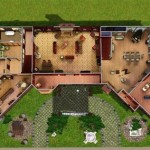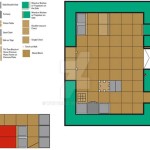500 Square Feet House Plans Tamilnadu Style
Designing a house within a limited footprint, such as 500 square feet, presents a unique challenge. When incorporating the architectural style of Tamil Nadu, the design task becomes even more intricate, requiring a thoughtful blend of traditional elements with modern functionality. This article explores various aspects of planning a 500 square feet house in the Tamil Nadu style, focusing on maximizing space, incorporating essential design features, and respecting the regional aesthetic.
Tamil Nadu's architectural heritage is rich and diverse, characterized by intricate carvings, vibrant colors, and a deep connection with nature. Traditional homes often feature courtyards, verandas, and sloped roofs, designed to mitigate the hot and humid climate. Adapting these elements to a compact 500 square feet space demands careful consideration and creative problem-solving.
The initial step in planning involves a detailed understanding of the site conditions. Factors such as orientation, soil type, and local building codes will significantly influence the design. The orientation of the house should ideally allow for maximum natural light and ventilation, reducing reliance on artificial lighting and air conditioning. Soil testing is crucial for determining the appropriate foundation type. Compliance with local building codes is essential to ensure the structural integrity and safety of the house.
Space optimization is paramount in a 500 square feet house. Every square inch must be utilized effectively. This necessitates a minimalist approach to design, focusing on essential features and avoiding unnecessary embellishments. Open floor plans can create a sense of spaciousness, blurring the lines between different living areas. Multi-functional furniture, such as sofa beds and storage ottomans, can further maximize space utilization.
The layout of the house typically includes a living area, a kitchen, a bedroom, and a bathroom. The living area can be combined with the dining area to create a larger, more versatile space. The kitchen should be compact and efficient, with well-organized storage solutions. The bedroom should be designed as a private and restful sanctuary. The bathroom should be functional and well-ventilated.
Key Point 1: Integrating Traditional Tamil Nadu Design Elements
Successfully integrating traditional Tamil Nadu design elements into a 500 square feet house requires selective adaptation. It is impractical to replicate the grandeur of larger traditional homes within such a limited space. Instead, the focus should be on incorporating subtle yet impactful details that evoke the essence of the style.
One approach is to use traditional materials, such as locally sourced wood, granite, and terracotta tiles. These materials can add warmth and character to the interior and exterior of the house. Traditional color palettes, featuring earthy tones and vibrant accents, can also enhance the aesthetic appeal. Intricate carvings can be incorporated in small doses, such as on the door frame or window surrounds.
Courtyards, a characteristic feature of traditional Tamil Nadu homes, can be adapted to a smaller scale by creating a small, enclosed garden area. This can be achieved by incorporating a small open space within the house or by creating a vertical garden on a wall. Verandas can be reinterpreted as small balconies or covered entryways, providing a space for relaxation and outdoor living.
The roof design can also reflect the Tamil Nadu style. Sloped roofs, traditionally used for rainwater runoff, can be adapted to a smaller scale. Alternatively, a flat roof can be incorporated with traditional parapet walls, adding a touch of elegance to the design. Proper insulation is essential to mitigate the effects of the hot climate, regardless of the roof design.
Ventilation is a critical aspect of traditional Tamil Nadu architecture. Natural ventilation can be enhanced by incorporating strategically placed windows and ventilators. Cross-ventilation, achieved by positioning windows on opposite sides of the house, can significantly improve air circulation. Orientation of the house to prevailing winds is equally crucial.
Key Point 2: Efficient Space Planning and Interior Design
The success of a 500 square feet house design hinges on efficient space planning and interior design. Every element must be carefully considered to maximize functionality and minimize clutter. The use of vertical space is particularly important in compact homes.
Storage solutions should be integrated into every available space. Built-in cabinets, shelves, and drawers can provide ample storage without occupying valuable floor space. Under-bed storage, wall-mounted shelves, and overhead cabinets are effective ways to utilize vertical space. Multi-functional furniture, such as sofa beds, folding tables, and storage ottomans, can serve multiple purposes, further maximizing space utilization.
Color schemes play a significant role in creating a sense of spaciousness. Light and neutral colors can make a room feel larger and brighter. Accents of bolder colors can be used to add visual interest and personality. Mirrors can also be used strategically to create the illusion of more space.
Minimizing clutter is essential in a small house. A minimalist approach to interior design can help to create a clean and uncluttered living environment. Prioritize essential items and avoid unnecessary decorations. Regular decluttering can help to maintain a sense of order and spaciousness.
Lighting is another crucial aspect of interior design. Natural light should be maximized by incorporating large windows and skylights. Artificial lighting should be carefully planned to create a warm and inviting atmosphere. Recessed lighting, track lighting, and pendant lights can be used to highlight specific areas of the house.
Key Point 3: Utilizing Sustainable and Cost-Effective Building Practices
Sustainable and cost-effective building practices are increasingly important in modern construction. A 500 square feet house provides an excellent opportunity to implement environmentally friendly and budget-conscious design strategies.
Using locally sourced materials can significantly reduce transportation costs and environmental impact. Locally available materials are often more affordable and better suited to the local climate. Reclaimed materials, such as recycled wood and bricks, can also be used to add character and reduce waste.
Energy efficiency is crucial in reducing long-term operating costs. Proper insulation, energy-efficient windows, and efficient appliances can significantly reduce energy consumption. Solar panels can be installed to generate electricity, further reducing reliance on the grid. Water conservation measures, such as low-flow toilets and showerheads, can help to conserve water.
Passive cooling techniques can reduce the need for air conditioning. Natural ventilation, shading devices, and reflective roof coatings can help to keep the house cool. Planting trees and shrubs around the house can provide shade and reduce the ambient temperature. A well-designed landscape can also enhance the aesthetic appeal of the house.
Water harvesting is another sustainable practice that can be implemented. Rainwater can be collected and stored for various uses, such as irrigation and toilet flushing. A rainwater harvesting system can help to conserve water and reduce water bills.
Designing a 500 square feet house in the Tamil Nadu style requires a blend of creativity, practicality, and cultural sensitivity. By carefully considering the site conditions, incorporating traditional design elements, optimizing space utilization, and implementing sustainable building practices, it is possible to create a functional, aesthetically pleasing, and environmentally friendly home.
In addition to the above-mentioned points, consideration should be given to the psychological impact of living in a small space. Proper lighting, natural elements, and a well-organized layout can contribute to a sense of well-being and comfort. Personalizing the space with meaningful objects and artwork can further enhance the living experience. The design should aim to create a sanctuary, a place where one feels safe, comfortable, and connected to their cultural heritage.

500 Sq Ft House Plans In Tamilnadu 1000 Small

21 X 20 Small Individual One Bedroom House 500 Sq Ft

28 X 17 Single Bedroom House Plans N Style Under 400 Square Feet

500 Sqft House Plan 2bhk 20 26 Tamil Er Anand

20 X 25 Beautiful House Plan For 2bhk In 500 Square Feet Low Cost

500 Sq Ft House Plans In Tamilnadu Small Farmhouse

16 X 28 Ground Floor Plan Under 450 Sq Ft House Model In

387 Sq Ft 2 Bedroom Single Floor Plan And Elevation Little House Plans Small Smart

10 Best 900 Sq Ft House Plans According To Vastu Shastra Styles At Life

25 X 30 Two Bedroom House Plans N Style Under 800 Square Feet








